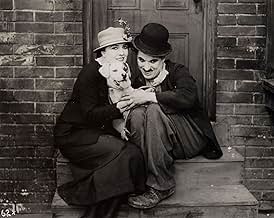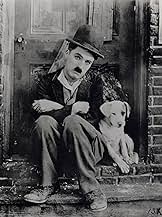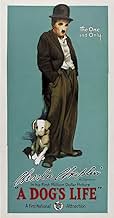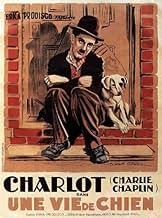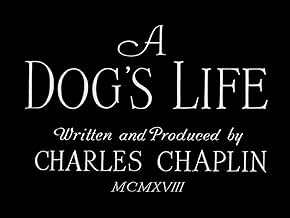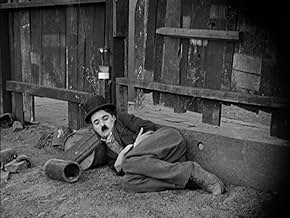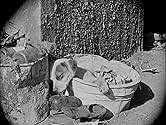IMDb रेटिंग
7.6/10
10 हज़ार
आपकी रेटिंग
अपनी भाषा में प्लॉट जोड़ेंThe Little Tramp and his dog companion struggle to survive in the inner city.The Little Tramp and his dog companion struggle to survive in the inner city.The Little Tramp and his dog companion struggle to survive in the inner city.
Edna Purviance
- Bar Singer
- (बिना क्रेडिट के)
Dave Anderson
- Bartender
- (बिना क्रेडिट के)
Bert Appling
- Unemployed Man
- (बिना क्रेडिट के)
Albert Austin
- Crook
- (बिना क्रेडिट के)
Henry Bergman
- Fat Unemployed Man
- (बिना क्रेडिट के)
- …
Alva D. Blake
- Man in Dance Hall
- (बिना क्रेडिट के)
Mel Brown
- Employment Agency Clerk
- (बिना क्रेडिट के)
- …
Minnie Chaplin
- Dance-Hall Dramatic Lady
- (बिना क्रेडिट के)
Syd Chaplin
- Lunchwagon Owner
- (बिना क्रेडिट के)
Dorothy Cleveland
- Woman in Dance Hall
- (बिना क्रेडिट के)
Slim Cole
- Unemployed Man
- (बिना क्रेडिट के)
Margaret Cullington
- Woman in Dance Hall
- (बिना क्रेडिट के)
Billy Dill
- Man in Dance Hall
- (बिना क्रेडिट के)
Margaret Dracup
- Woman in Dance Hall
- (बिना क्रेडिट के)
Jack Duffy
- Man in Dance Hall
- (बिना क्रेडिट के)
Robert Dunbar
- Old Man in Dance Hall
- (बिना क्रेडिट के)
Ella Eckhardt
- Woman in Dance Hall
- (बिना क्रेडिट के)
फ़ीचर्ड समीक्षाएं
By the time he made `A Dog's Life', Charlie Chaplin was already a master of cinematic comic timing. Editing techniques had not developed to the point at which they would be much help to Chaplin's physical comedy gags, so laughs required expertly handled choreography. Chaplin must have rehearsed countless takes to get each scene just right. The incredible opening sequence, seemingly shot all in one take, is particularly amazing. Chaplin and his fellow actors synchronize their movements perfectly so that, no matter what action they undertake, they always arrive on opposite sides of the fence at the exact same moment. Additionally, they make each movement at a natural pace so that, rehearsed though they may be, their motions always seem spontaneous and believable. You never get the sense that Chaplin or the policemen are speeding up or slowing down.
Rating: 6.5
Rating: 6.5
Of Charlie Chaplin's many works, "A Dog's Life" is in my top 5, under "The Kid", "City Lights" and "Modern Times". Though just a short, I think this film is one of Chaplin's funniest and most poignant of them all. It had me laughing the whole time and this is the film that made me fall in love with his hands: It was the miming scene where the Tramp has to pretend to be the bully he's just knocked out, to get the wallet back, simply by using hand gestures! It's a moment that shines for all silent movies, showing how little sound is needed to communicate - it's a favorite scene of mine. This is a great film, and especially when coupled with "The Kid" (Chaplin's best work, I think, and my favorite film of all time) how could *anyone* refuse?
Just like his little tramp alter ego, Charlie Chaplin liked to think big, and had always aimed to extend the scale and scope of his pictures, never content to be a two-reel sideshow. At 35 minutes, A Dog's Life could hardly be described as his first full-length feature, but it arguably represents his break away from shorts.
Just the opening shot of A Dog's Life shows how Chaplin is starting to inject some grand sweep into his storytelling. The camera begins amid city rooftops, tilting down to reveal Charlie sleeping amid the rubbish behind a ramshackle fence. The way this purpose-built set is shot demonstrates how Chaplin was as much a "proper" director as a comic. He several times has a shabby sign advertising "rooms" visible in the background – a subtle reminder that the tramp is too poor even for the cheapest accommodation.
It's a nice touch how Charlie's canine friend is introduced in a handful of cutaways during this opening scene – treating him as a real character rather than just a plot device. But this is not to the detriment to his human companions, and indeed leading lady Edna Purviance gets a more substantial part than she did in many of the shorts. She makes a really great character here, giving an impression of a naïve but feisty youngster, certainly more than just a token female. It's this kind of characterisation that gives A Dog's Life the kind of comprehensive structure of a feature film, as opposed to a comedy short in which people just turn up on screen for a bit of funny business.
On a quick side-note, this is the earliest Chaplin picture which features a score written by him (although since he wrote the music in retrospect some decades later it's not the first he wrote). It's another testament to the breadth of his genius, showing both considerable musical ability as well as his own irreverent personality. Numbers like the dance hall rag are of course very "silent comedy", but pieces like the opening theme have a truly deep and epic feel to them. Even here though, the Chaplin cheekiness shines through, with different parts of the orchestra playing off each other in a kind of question-and-answer routine.
Chaplin would repeat this "little companion" routine, swapping dog for tot in his first genuine full-length feature The Kid. A Dog's Life remains a worthy predecessor, part of the comedian's ever upward trajectory at this point in his career. It would take more battling with studio heads for Chaplin to get his ideas fully realised, but it was pictures like this that began to get silent comedy taken seriously.
Just the opening shot of A Dog's Life shows how Chaplin is starting to inject some grand sweep into his storytelling. The camera begins amid city rooftops, tilting down to reveal Charlie sleeping amid the rubbish behind a ramshackle fence. The way this purpose-built set is shot demonstrates how Chaplin was as much a "proper" director as a comic. He several times has a shabby sign advertising "rooms" visible in the background – a subtle reminder that the tramp is too poor even for the cheapest accommodation.
It's a nice touch how Charlie's canine friend is introduced in a handful of cutaways during this opening scene – treating him as a real character rather than just a plot device. But this is not to the detriment to his human companions, and indeed leading lady Edna Purviance gets a more substantial part than she did in many of the shorts. She makes a really great character here, giving an impression of a naïve but feisty youngster, certainly more than just a token female. It's this kind of characterisation that gives A Dog's Life the kind of comprehensive structure of a feature film, as opposed to a comedy short in which people just turn up on screen for a bit of funny business.
On a quick side-note, this is the earliest Chaplin picture which features a score written by him (although since he wrote the music in retrospect some decades later it's not the first he wrote). It's another testament to the breadth of his genius, showing both considerable musical ability as well as his own irreverent personality. Numbers like the dance hall rag are of course very "silent comedy", but pieces like the opening theme have a truly deep and epic feel to them. Even here though, the Chaplin cheekiness shines through, with different parts of the orchestra playing off each other in a kind of question-and-answer routine.
Chaplin would repeat this "little companion" routine, swapping dog for tot in his first genuine full-length feature The Kid. A Dog's Life remains a worthy predecessor, part of the comedian's ever upward trajectory at this point in his career. It would take more battling with studio heads for Chaplin to get his ideas fully realised, but it was pictures like this that began to get silent comedy taken seriously.
A Dog's Life has more layers than the usual Chaplin films, taking the character slightly more literally than he usually does. The overall appeal of Chaplin's Little Fellow is that he is such an everyman that he can be thrust into an almost endless multitude of situations, and Chaplin uses his limitless talent to mold it into brilliant, humanitarian farce. In this film, the little tramp is more of a homeless fellow than usual (I think he's usually just poor and struggling), and in the process he be-friends another homeless and struggling tramp.
There are some great scenes in the film, although even at only 40 minutes it is a bit too long for the material to support. One scene in particular, where Charlie knocks a bully unconscious, is going to be the most memorable one in the movie, along with a scene where he outsmarts some police officers. There is a charming romance that is neither cloying nor overly involving, just the right amount for a short, light-hearted comedy. This probably would have worked even better as a two reel film, but as it is it stands as one of Chaplin's better three reelers.
There are some great scenes in the film, although even at only 40 minutes it is a bit too long for the material to support. One scene in particular, where Charlie knocks a bully unconscious, is going to be the most memorable one in the movie, along with a scene where he outsmarts some police officers. There is a charming romance that is neither cloying nor overly involving, just the right amount for a short, light-hearted comedy. This probably would have worked even better as a two reel film, but as it is it stands as one of Chaplin's better three reelers.
Let's face it : Chaplin's short films, before 1917, are not so good and funny anymore. After 1917, and waiting to make longer films, there are three films I'm really found of : The Imigrant, Shoulder Arms and A Dog's Life. I love A Dog's Life because Chaplin was never trampier than in this film. He's poor, miserable, probably dirty! He really looks like a real tramp! So is his dog! The dog is simply wonderful in this film!
Funny gags all the way. I'm mad about a scene in the café, when Edna Purviance sings a very sad song and makes everybody's crying. In my version, on video, they put some strange music while she sings, like a saw sound. It's a very funny sounds effect for the image of miss Purviance! The story is very sample and warm. This is Chaplin's shorts at his best!
Funny gags all the way. I'm mad about a scene in the café, when Edna Purviance sings a very sad song and makes everybody's crying. In my version, on video, they put some strange music while she sings, like a saw sound. It's a very funny sounds effect for the image of miss Purviance! The story is very sample and warm. This is Chaplin's shorts at his best!
क्या आपको पता है
- ट्रिवियाThis was Charles Chaplin's first film for First National Pictures under a $1M contract where Chaplin had full creative control over his films for the first time.
- गूफ़During the fight at the lunch cart, one of the props holding up the awning gets knocked away. In subsequent shots, the prop is back in place.
- भाव
Title Card: When dreams come true.
- कनेक्शनEdited into The Chaplin Revue (1959)
टॉप पसंद
रेटिंग देने के लिए साइन-इन करें और वैयक्तिकृत सुझावों के लिए वॉचलिस्ट करें
विवरण
- रिलीज़ की तारीख़
- कंट्री ऑफ़ ओरिजिन
- आधिकारिक साइटें
- भाषाएं
- इस रूप में भी जाना जाता है
- I Should Worry
- फ़िल्माने की जगहें
- उत्पादन कंपनी
- IMDbPro पर और कंपनी क्रेडिट देखें
- चलने की अवधि33 मिनट
- रंग
- ध्वनि मिश्रण
- पक्ष अनुपात
- 1.33 : 1
इस पेज में योगदान दें
किसी बदलाव का सुझाव दें या अनुपलब्ध कॉन्टेंट जोड़ें

